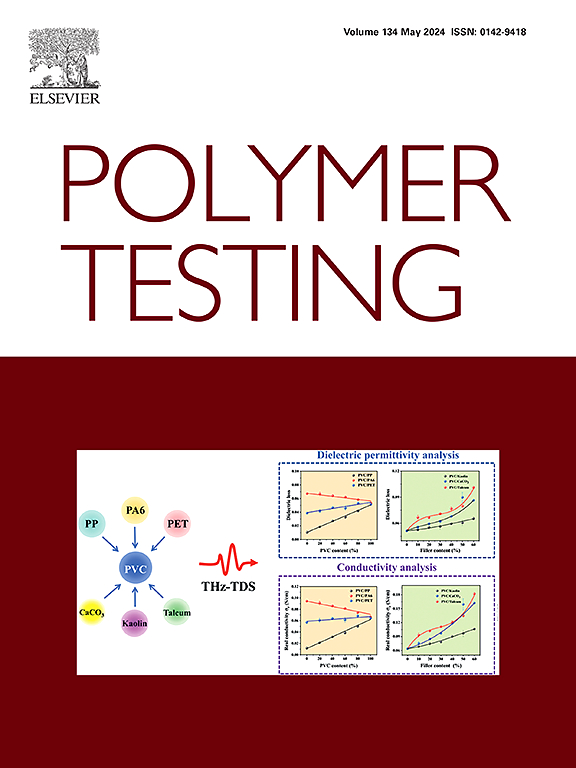The effect of biodegradable polymer blending on the disintegration rate of PHBV, PBS and PLA in soil
IF 5
2区 材料科学
Q1 MATERIALS SCIENCE, CHARACTERIZATION & TESTING
引用次数: 0
Abstract
This study generates new insights into the disintegration phenomena that take place upon blending different classes of biodegradable polymers. Polymer blending is found to be an effective method to tailor the disintegration rate of these polymers in soil. It is shown that the biodegradation of poly(hydroxybutyrate-co-hydroxyvalerate) (PHBV) can be accelerated by blending with poly(butylene succinate-co-adipate) (PBSA) and polycaprolactone (PCL). The observed high rate of disintegration of poly(butylene succinate) (PBS) in soil (severe deterioration in 4 weeks, and fragmentation in 4 months) does not fully align with its current reputation in the market as a polymer that is non-biodegradable in soil. Disintegration trials executed in soil media with different inoculants demonstrate that the biodegradation rate of PBS in soil is highly dependent on the specific soil conditions. Moreover, it is shown that the biodegradation of PBS can be substantially accelerated by blending it with PBSA (fragmentation in 8 weeks). Finally, it is shown that the disintegration of poly(lactic acid) (PLA) in soil can be enhanced by blending it with PCL. Experiments that monitor the CO2 evolution of these blends, both in soil and in home composting environments, demonstrate that not just the disintegration, but also the overall biodegradation of PLA is enhanced by blending with PCL (39 % conversion to CO2 in 12 months incubation in soil; 89 % conversion to CO2 in 6 months incubation in home composting conditions). This opens up possibilities for targeted blending strategies to reduce potential accumulation of PLA-based plastics in soil environments.
可生物降解聚合物共混物对 PHBV、PBS 和 PLA 在土壤中崩解率的影响
这项研究对不同种类的生物可降解聚合物混合后发生的崩解现象提出了新的见解。研究发现,混合聚合物是调整这些聚合物在土壤中分解速度的有效方法。研究表明,通过与聚(丁二酸丁二醇酯-共聚己二酸丁二醇酯)(PBSA)和聚己内酯(PCL)混合,可以加速聚(羟基丁酸-共羟基戊酸)(PHBV)的生物降解。据观察,聚丁二酸丁二醇酯(PBS)在土壤中的崩解率很高(4 周内严重变质,4 个月内碎裂),这与它目前在市场上作为一种在土壤中不可生物降解的聚合物的声誉并不完全相符。在土壤介质中使用不同的接种剂进行的分解试验表明,PBS 在土壤中的生物降解率在很大程度上取决于特定的土壤条件。此外,试验还表明,将 PBS 与 PBSA 混合可大大加快 PBS 的生物降解速度(8 周后即可分解)。最后,实验还表明,聚乳酸(PLA)在土壤中的分解可以通过与 PCL 混合而得到加强。监测这些混合物在土壤和家庭堆肥环境中二氧化碳演化的实验表明,通过与 PCL 混合,不仅增强了聚乳酸的分解能力,还增强了聚乳酸的整体生物降解能力(在土壤中培养 12 个月,二氧化碳转化率为 39%;在家庭堆肥条件下培养 6 个月,二氧化碳转化率为 89%)。这为有针对性的混合策略提供了可能性,以减少聚乳酸基塑料在土壤环境中的潜在积累。
本文章由计算机程序翻译,如有差异,请以英文原文为准。
求助全文
约1分钟内获得全文
求助全文
来源期刊

Polymer Testing
工程技术-材料科学:表征与测试
CiteScore
10.70
自引率
5.90%
发文量
328
审稿时长
44 days
期刊介绍:
Polymer Testing focuses on the testing, analysis and characterization of polymer materials, including both synthetic and natural or biobased polymers. Novel testing methods and the testing of novel polymeric materials in bulk, solution and dispersion is covered. In addition, we welcome the submission of the testing of polymeric materials for a wide range of applications and industrial products as well as nanoscale characterization.
The scope includes but is not limited to the following main topics:
Novel testing methods and Chemical analysis
• mechanical, thermal, electrical, chemical, imaging, spectroscopy, scattering and rheology
Physical properties and behaviour of novel polymer systems
• nanoscale properties, morphology, transport properties
Degradation and recycling of polymeric materials when combined with novel testing or characterization methods
• degradation, biodegradation, ageing and fire retardancy
Modelling and Simulation work will be only considered when it is linked to new or previously published experimental results.
 求助内容:
求助内容: 应助结果提醒方式:
应助结果提醒方式:


